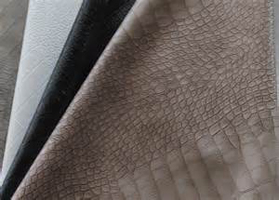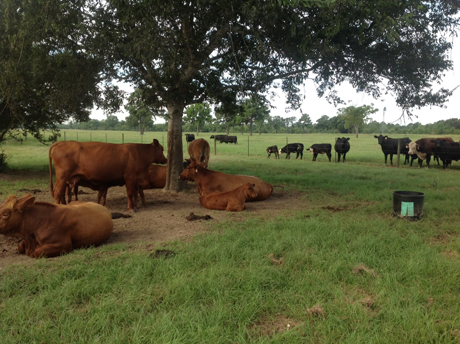
Leather is one of man's earliest and most useful discoveries. Our ancestors used leather to protect themselves from the elements. Primitive man hunted wild animals for food, then made clothing, footwear and crude tents from the hides. Like then, hides used today are a by-product. Animals are raised for the meat, dairy and wool industries, not for their hides. Roughly half of all leather produced today is used to make shoes, and about 25% for clothing. Upholstery demands only around 15% of the total product. captions The tanning process from the early 1900's. Wall paintings and artifacts in Egyptian tombs dating back to 5000 B.C. indicate that leather was used for sandals, clothes, gloves, buckets, bottles, shrouds for burying the dead and for military equipment. The ancient Greeks are credited with developing tanning formulas using certain tree barks and leaves soaked in water to preserve the leather. This was the first record of vegetable tanned leather, which became a well-established trade in Greece around 500 B.C. Vegetable tanned leathers are still produced today and remain an active ingredient in modern tannages. The Romans made extensive use of leather for footwear, clothes, and military equipment including shields, saddles and harnesses. Due to its durability and comfort, leather has been used for seating throughout the history of transportation and furniture. It has always been the ideal material for making saddles and tack, as well as footwear. During the Middle Ages, leather became the cover of choice for dining chairs, because it was easy to maintain and did not absorb the odor of food. The spread of industrialization in the 18th and 19th centuries created a demand for new kinds of leathers, such as belting leathers to drive machinery. The invention of the automobile, the demand for softer, lightweight footwear with a fashionable appearance, and a general rise in the standard of living created a demand for soft, supple, colorful leather. The traditional vegetable tanned leather was too hard and thick for these requirements and thus, the use of chromium salt was adopted and chrome tanning became the standard for modern footwear, fashion and upholstery leathers. Modern technology has allowed for innovation in the leather industry, as the development of chemicals and sophisticated processing methods have greatly expanded the aesthetics and feel of leather as well as the possible applications. Leather continues to be the material of choice, not just for commercial and residential furniture but for automotive, aviation and marine applications as well.
The Controversy of Using Leather

Because (leather) is made from animal skin, some people find it to be a controversial material. (Leather) is made by preparing the hide of animals (usually cow, sheep, or lamb) through the process of tanning. (Leather) is a popular choice for furniture, car interiors, and clothing such as gloves and jackets because it ages well and becomes softer and more comfortable over time. Fans of (real leather) love the expensive look and believe that it retains warmth much better than its faux counterpart. Leather used in furniture is a byproduct of the meat industry, so what would normally go to waste is used in the automotive, furniture, hospitality , marine and clothing industry.
People who are against (leather) feel the (leather) industry is closely tied to the meat industry, which they say can be particularly cruel to animals. Some people feel that such cruelty is unnecessary when synthetic materials are so readily available. Some processes in the past have been known to be hazardous to human health. Many of the chemicals that are used in the preserving process are linked to nausea, headaches, asthma, respiratory infections, and other illnesses. Manmade materials can pose these same if not more issues related to health as artifical processes are required to emulate the real thing.
Faux vs. Authentic
Examine the Pores
When making a leather purchase, closely examine the pores of the fabric. Faux leather will have pores that are in a consistent pattern, while real leather will have inconsistently placed pores.
Touch the Leather
Depending on the quality, real leather can feel coarse or smooth, or anywhere in between. Leather is also flexible and soft. If the item in questions feels really smooth or has a similar feel to plastic, it is likely fake leather. Faux leather also tends to stretch more than real leather. To become familiarized with the feel of real and faux leather, go to a reputable leather store and feel real leather to compare it to faux leather.
Smell the Item
Smell the object for the distinct leather smell. The smell of real leather cannot be replicated by synthetic materials. It may help to go to a department store and smell real leather items and faux leather items to become acquainted with the smell.
Comparing Real and Faux Leather
Real and faux leather have many different qualities. Each type has advantages and disadvantages. Consider several factors when making a leather purchase.
Advantages of Authentic Leather
There is nothing like the smell and feel of real leather. Real leather gives an aura of luxury and prestige. Because no two animal hides are exactly the same, each piece of authentic leather has unique natural characteristics. The leather becomes softer and more attractive over time, which makes it more comfortable. Leather also has a soft, yet strong texture, making it hard-wearing. Many real leather products are also treated to help prevent stains. Leather is easy to take care of when maintained properly; it only needs a regular wiping with a clean, damp cloth.
Disadvantages of Authentic Leather
Real leather is much more expensive than its counterpart. If leather is in constant sunlight, the color may fade. Leather is very porous and absorbent naturally if a pure aniline, so drops of liquid will quickly soak into the item if not wiped up promptly. If the leather is not protected, this can result in a stain, so an aniline plus or pigmented leather is sometimes more pratical.
Advantages of Faux Leather
Faux leather has a similar look and feel to genuine leather, while being much more affordable. Some people prefer faux leather simply because no animals are harmed in the making of the material. Faux leather is made from a machine, which ensures that the fabric has an even, consistent color throughout. It can also be dyed into many different colors, and is usually fade resistant.
Disadvantages of Faux Leather
Traditional (faux leather) is also much less durable than (real leather) and tends to last only a fraction of the time. Plastic easily cracks and fades with use, whereas (real leather) develops a patina with age. Nevertheless, (faux leather) is a cheaper common choice for furniture upholstery since the cost of real leather has risen. Caring for faux (leather furniture) is very easy-it can usually be cleaned once a week by wiping gently with a microfiber cloth and a solution of water mixed with a small amount of dish soap.
Advantages of Authenic (Real leather) is often described as being more environmentally friendly than faux. There is nothing like the smell and feel of real leather. Real leather gives an aura of luxury and prestige. Because no two animal hides are exactly the same, each piece of authentic leather has unique natural characteristics. The leather becomes softer and more attractive over time, which makes it more comfortable. Leather also has a soft, yet strong texture, making it hard-wearing. Many real leather products are also treated to help prevent stains. Real (leather furniture) is easy to maintain with a very mild soap ( water based soft cleaner like nutragena) and water . Normal routine maintenance with a damp cloth to remove dust is usually all that is needed. Body oils from skin contact and hair can result in detoriating of the protective finish applied to aniline plus or pigmented leather, so cleaning these areas periodically is necessary
Further Resources
Learn more about real and faux leather:
- Guide for Leather and Imitation Leather Products
- How leather is made
- Commission Approves Retention of Leather Guides
- About Leather

- Different Kinds of Facts on Leather
- Caring for Leather Furniture
- About Faux Leather
- Leather and the Environmental impact
- Leather Alternatives
- Bonded Leather Sofas vs. Genuine Leather- What's the Difference?












